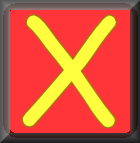
This page has moved. Please reset your links to:
http://www.transum.org/software/SW/Starter_of_the_day/Students/Areas_of_Composite_Shapes.asp
 |
Compound ShapesFind the area of shapes made up of one or more simple polygons and circles |
This is level 2; Using letters to show how the areas of compound shapes are calculated.
If the area of

 is
a and the area of
is
a and the area of

 is b then the area of this compound
is b then the area of this compound
shape
 is 2a - b. Find the simplest way of expressing the areas of these shapes:
is 2a - b. Find the simplest way of expressing the areas of these shapes:
This is Compound Shapes level 2. You can also try:
See also Missing lengths and areas of circles for more practice.
InstructionsTry your best to answer the questions above. Type your answers into the boxes provided leaving no spaces. As you work through the exercise regularly click the "check" button. If you have any wrong answers, do your best to do corrections but if there is anything you don't understand, please ask your teacher for help. When you have got all of the questions correct you may want to print out this page and paste it into your exercise book. If you keep your work in an ePortfolio you could take a screen shot of your answers and paste that into your Maths file. |
||
|
|
||
|
|

|
More Activities: |
|
Mathematicians are not the people who find Maths easy; they are the people who enjoy how mystifying, puzzling and hard it is. Are you a mathematician? Comment recorded on the 7 April 'Starter of the Day' page by Marta, Rosea: "Hello! I wanted to comment that these starters always brighten my day. My students and I are very grateful to have access to these resources. Thank you!" Comment recorded on the 28 May 'Starter of the Day' page by L Smith, Colwyn Bay: "An absolutely brilliant resource. Only recently been discovered but is used daily with all my classes. It is particularly useful when things can be saved for further use. Thank you!" |
Each month a newsletter is published containing details of the new additions to the Transum website and a new puzzle of the month. The newsletter is then duplicated as a podcast which is available on the major delivery networks. You can listen to the podcast while you are commuting, exercising or relaxing. Transum breaking news is available on Twitter @Transum and if that's not enough there is also a Transum Facebook page. |
|
AnswersThere are answers to this exercise but they are available in this space to teachers, tutors and parents who have logged in to their Transum subscription on this computer. A Transum subscription unlocks the answers to the online exercises, quizzes and puzzles. It also provides the teacher with access to quality external links on each of the Transum Topic pages and the facility to add to the collection themselves. Subscribers can manage class lists, lesson plans and assessment data in the Class Admin application and have access to reports of the Transum Trophies earned by class members. If you would like to enjoy ad-free access to the thousands of Transum resources, receive our monthly newsletter, unlock the printable worksheets and see our Maths Lesson Finishers then sign up for a subscription now: Subscribe |
||
Go MathsLearning and understanding Mathematics, at every level, requires learner engagement. Mathematics is not a spectator sport. Sometimes traditional teaching fails to actively involve students. One way to address the problem is through the use of interactive activities and this web site provides many of those. The Go Maths page is an alphabetical list of free activities designed for students in Secondary/High school. Maths MapAre you looking for something specific? An exercise to supplement the topic you are studying at school at the moment perhaps. Navigate using our Maths Map to find exercises, puzzles and Maths lesson starters grouped by topic. | ||
Teachers | ||
|
If you found this activity useful don't forget to record it in your scheme of work or learning management system. The short URL, ready to be copied and pasted, is as follows: |
Alternatively, if you use Google Classroom, all you have to do is click on the green icon below in order to add this activity to one of your classes. |
It may be worth remembering that if Transum.org should go offline for whatever reason, there is a mirror site at Transum.info that contains most of the resources that are available here on Transum.org. When planning to use technology in your lesson always have a plan B! |
|
|
||
Close

Level 1 - A reminder of the area formulas for basic shapes
Level 2 - Using letters to show how the areas of compound shapes are calculated
Level 3 - Compound shapes made up of rectangles
Level 4 - Compound shapes made up of rectangles and triangles
Level 5 - Compound shapes made up of quadrilaterals and triangles
Level 6 - Compound shapes made up of quadrilaterals, triangles and circles
Level 7 - Real life compound area questions from photographs
Rectangle: |
Triangle: |
Parallelogram: |
Trapezium: |
Kite: |
Circle: |
Close
